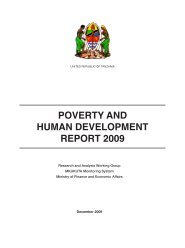Download PDF (4.08 MB) - ReliefWeb
Download PDF (4.08 MB) - ReliefWeb
Download PDF (4.08 MB) - ReliefWeb
Create successful ePaper yourself
Turn your PDF publications into a flip-book with our unique Google optimized e-Paper software.
CHAPTER 2<br />
LIVELIHOODS AND ECONOMIC<br />
RECOVERY ASSESSMENT<br />
Contents<br />
2.1 What information does a livelihoods<br />
and economic recovery assessment provide? 14<br />
2.1.1 Livelihood assets of individuals, households, and communities 14<br />
2.1.2 Local economy 15<br />
2.1.3 “Macro” issues and micro-macro linkages 16<br />
2.1.4 Conflict and disaster risk 17<br />
2.2 How is a livelihoods and economic recovery<br />
assessment conducted? 18<br />
2.2.1 Assessment team 18<br />
2.2.2 Timing of the assessment 18<br />
2.2.3 Information collection methods 19<br />
2.2.4 Components of the assessment 19<br />
2.2.5 Partnerships and participation 20<br />
2.3 How can the assessment translate into a<br />
programme?21<br />
Programmes in crisis and post-crisis situations<br />
can achieve their goals—and avoid inadvertently<br />
causing harm—only when they are based on solid<br />
assessments. Livelihoods and economic recovery<br />
assessments provide information on the social and<br />
economic context of a crisis or post-crisis situation.<br />
Such assessments cover issues at both the “micro”<br />
level (individuals, households, and communities)<br />
and the “macro” level (the state of the economy,<br />
the policy framework, and the nature and quality<br />
of governance). The more practitioners know<br />
about the situations they are trying to address, the<br />
more likely they are to identify effective avenues<br />
for programme development, and the less likely<br />
they are to make mistakes. Moreover, a successful<br />
assessment process will strengthen local capacity<br />
for inclusive and participatory analysis, help<br />
vulnerable people to have an effective voice in<br />
decision-making, and create gender, conflict, and<br />
disaster-risk sensitivity.<br />
At the individual, household, and community<br />
levels, a livelihoods and economic recovery assessment<br />
identifies the capital assets (human,<br />
natural, physical, financial, political, and social) of<br />
crisis-affected people, their livelihood strategies,<br />
and the ways in which they cope with vulnerability.<br />
At the local and national levels, such an assessment<br />
demonstrates how the economy, the system<br />
of governance, and the physical environment<br />
influence crisis-affected people and, indeed, are<br />
in turn influenced by them, as well as by socioeconomic<br />
opportunities. And, additionally, the<br />
assessment reveals the power structures in place<br />
at all levels, including those that are related to<br />
gender, ethnicity, and other personal, family, or<br />
community characteristics, while also analyzing<br />
the conflict and disaster risk scenarios.<br />
Each crisis or post-crisis situation is unique.<br />
Therefore, the most appropriate design of an<br />
assessment—the information to be sought, the<br />
methods of seeking it, and the duration of the<br />
assessment—will be different in every case. The<br />
assessment design needs to be tailored according<br />
to the nature and stage of the crisis, the timeframe<br />
for response, the size and accessibility of crisisaffected<br />
communities, the availability of local data<br />
and expertise, the security situation, the logistical<br />
support available, and other characteristics of the<br />
particular situation. It is usually the case that quick<br />
assessments are necessary, with periodic updates<br />
that enable programmes to respond to a rapidly<br />
changing environment.<br />
This chapter provides guidance on the information<br />
a livelihoods and economic recovery assessment<br />
provides (section 2.1), how such an assessment<br />
is conducted (section 2.2), and how a visioning<br />
process can enable the translation of the assessment<br />
into a programme (section 2.3). References<br />
and suggested further reading are provided at the<br />
end of the chapter.





